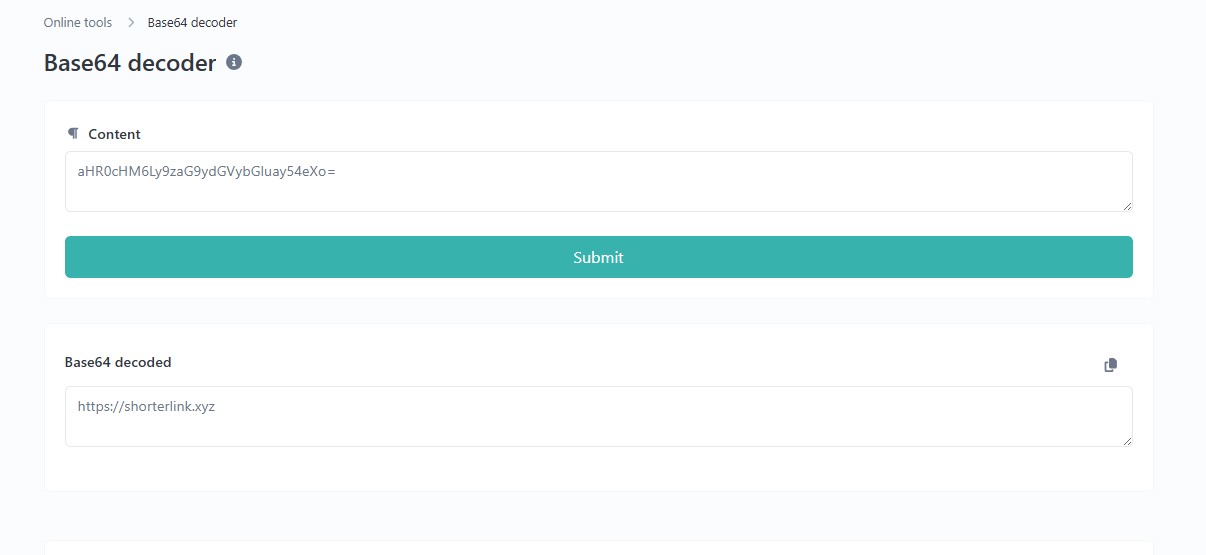
Base64 Decoder: Unpacking Encoded Data Made Easy
Created on 12 October, 2025 • Converter Tool • 0 views • 4 minutes read
Discover what a Base64 decoder is, how it works, and why it's essential for decoding encoded data across websites, APIs, and tools like shorterlink.xyz.
The internet is full of encoded information. Whether you're working with files, links, or digital communication systems, you’ve likely come across Base64-encoded data. While encoding ensures data can travel safely across systems, decoding is just as important to retrieve the original content. This is where a Base64 decoder becomes essential. In this article, we'll explore how Base64 decoding works, why it's used, and how platforms like shorterlink.xyz benefit from decoding processes to enhance services and user experience.What Is Base64 Decoding?
Base64 decoding is the process of converting data that was previously encoded in Base64 format back to its original form. Base64 encoding turns binary or non-textual data (like images, files, or special characters) into a plain-text format. A decoder reverses this transformation, returning the encoded data to its original state.
In simple terms, if Base64 encoding is packaging your data for safe travel, decoding is unwrapping that package so you can use the contents.
Why Base64 Decoding Matters
1. Recovers Usable Data
Without decoding, Base64-encoded content is meaningless to users and systems. A decoder transforms this encoded string back into its original format—be it an image, document, or text—making it accessible and useful again.
2. Enables Secure Data Handling
Base64 isn’t an encryption method, but it’s often used in conjunction with secure systems. For instance, data sent via APIs or secure URLs may be encoded. Decoding on the receiving end ensures the information can be correctly interpreted without corruption.
3. Supports Interoperability
Systems and applications communicate in different ways. Base64 helps bridge the gap by providing a common format. Decoding ensures systems can understand and interact with incoming data, no matter where it comes from.
How Base64 Decoding Works
Although we won't dive into technical code, the concept is simple. Base64 encoding turns data into a string using 64 different characters (letters, numbers, and symbols). A decoder reads that string, reverses the encoding process, and restores the original binary or text data.
For example, when a document or image is encoded to travel over the internet, it becomes a long, unreadable string. Base64 decoding takes that string and reconstructs the original file so it can be viewed or used properly.
Real-Life Uses of Base64 Decoding
Email Systems
Many email services use Base64 to handle attachments and images. When an attachment is received, the client decodes the Base64 string so the recipient can view or download the file.
Web Applications
Web developers often embed Base64-encoded images, icons, or files directly in HTML or CSS. When a browser loads the webpage, it decodes the Base64 strings to render the visuals correctly.
APIs and Data Transfer
APIs frequently receive Base64-encoded data—such as user credentials, tokens, or binary files. A decoding process is required on the backend to turn that data back into a usable form for processing or storage.
The Role of Base64 Decoder at shorterlink.xyz
At shorterlink.xyz, Base64 decoding plays a subtle yet vital role. When users shorten URLs with embedded data or parameters, that information is often encoded for safety and compatibility. Later, the system decodes it to handle redirects or retrieve metadata.
Whether it's a token included in a shortened link or a secure query string, decoding ensures that shorterlink.xyz can read and process the information accurately and instantly. This enhances both security and performance.
Additionally, users might input Base64-encoded strings manually—for example, as part of a toolset to decode secure text, view hidden parameters, or check information within a shortened link. shorterlink.xyz can integrate decoding tools to assist with these actions seamlessly.
Benefits of Using a Base64 Decoder
Fast and Efficient
Decoding is usually instantaneous. Whether it’s happening on a website or app, the process is lightweight and doesn’t demand much computing power.
Cross-Platform Compatibility
Since Base64 uses plain text, it works across different operating systems, programming languages, and applications. A Base64 decoder ensures this compatibility translates into actual, usable data.
Essential for Developers and Users Alike
Developers use decoders to test and debug APIs. Regular users may rely on decoders to retrieve encoded content sent via links, emails, or web tools. Having access to a reliable decoding solution is essential in both scenarios.
Limitations and Considerations
While Base64 decoding is useful, it's important to note that Base64 is not secure by itself. Anyone with access to the encoded string can decode it. For sensitive data, Base64 should be combined with encryption methods to ensure security.
Also, Base64 increases the size of data by about 33%. So, while decoding restores the data, it doesn’t reduce the transmission size impact already caused by encoding.
Conclusion
A Base64 decoder is an essential tool for converting encoded data back to its original form. It supports everything from email attachments and API calls to shortened URLs and embedded files. Platforms like shorterlink.xyz rely on decoding processes to maintain speed, security, and accuracy in delivering web services.
As the internet becomes more reliant on encoded data, the role of decoding will only grow in importance. Whether you're a developer, digital marketer, or everyday user, understanding how Base64 decoding works gives you more control and insight into your online tools and data.